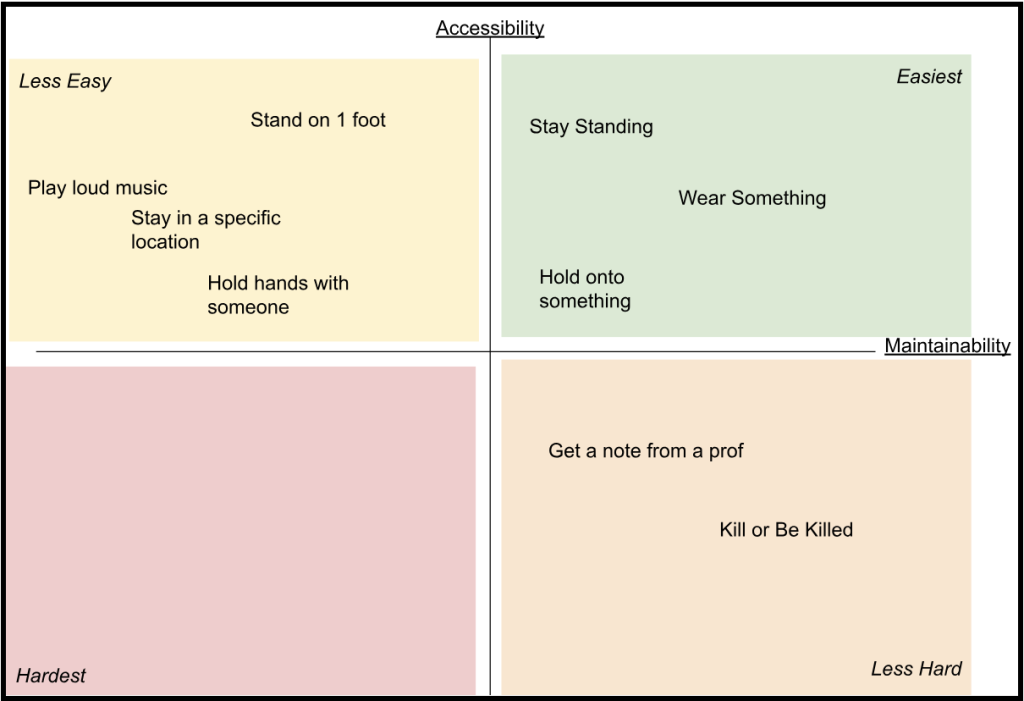Spoon Assassins is a highlight of Olin culture, and it does so by accomplishing these main experience goals for the members of Olin college:
- Meet people you would not otherwise interact with.
- Experience locations on and off campus with a new perspective and appreciation.
- Get a damn good story out of it.
The game serves three player archetypes. Personas, if you will:
- Vib’n Viney: “I’ll stick this out as long as I can”
- Tryhard Terry: “I’ll pursue any opportunity to make a kill”
- Onlooker Amy: “Not my game, but it’s funny to watch” (encompassing staff and faculty in addition to students)
Different structures are in place to cater to different player archetypes. Safety zones for class or speaking with staff and faculty appeal to Amy. Easy safeties allow Viney to feel like they get to participate in Olin culture, and the escalation of difficult safeties allows Terry to put all his energy into something enjoyable. The game also involves Amy by enabling her to collaborate with or betray active players.
Games tell stories, and these story arcs are measured by how many resources a player is given at the beginning, and then changing that resource in a specific direction. Games like checkers start a player off with the most pieces they will have at any point in the game, and slowly whittle away until the players are fighting for scraps. Scrabble starts players off with no letters on the field, and the rate of scoring points escalates as more and bigger words can be assembled.
The arc of Spoon Assassins is oriented around two resources:
- Safety: A game begins with “easy” safety, and slowly that safety is less accessible.
- Knowledge: As you play, you gain a greater understanding of how to find/assassinate your target.
There are two axes to evaluate how a Spoon Assassins safety can be made “easy” or “hard”:
- Accessibility: How easy it is to quickly move from unsafe to safe.
- Maintainability: How easy it is to continue being safe once made safe.
I took the liberty of making an arbitrary 2×2 in order to exemplify this concept.

As time progresses, the “easiness” of the safeties should decrease accordingly. This can fluctuate of course, as creating the swings in difficulty make the game feel more intense, but the general trend should remain moving from green to red with deliberate deviation. As the game continues, however, access to information should increase. To advance the game, the most important information a player can have is how to kill their target. Evaluating how safeties provide this information can be measured across a linear scale:

Safeties that are difficult to access or maintain are only one half of what it takes to accelerate the game. Players that know their target and are able to track them are much more lethal assassins.
All these rules can be followed and still generate a boring game. This is where the true role of the game masters lies! It is their creative flare that fuels good stories the Olin community can share. That’s the reason why safeties are ridiculous, and it’s why they facilitate kills as opposed to letting players hide in their room all day.
Ultimately, those unforgettable moments come down to how the player engages with the game. It’s not like the game masters can guarantee a dramatic tale, but Spoon Assassins is a great experience to be a part of because all the structures in place make this play experience like no other. I commend the game masters for their facilitation and their endless rules-clarification, and I commend you for the ways you contributed to the game, even if you weren’t playing.
What I’m trying to say is that Spoon Assassins is a big DesNat play experience where the bio-inspiration is an Oliner that’s cooler than you.



